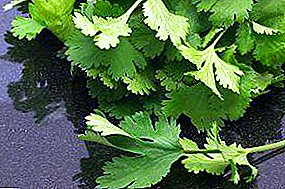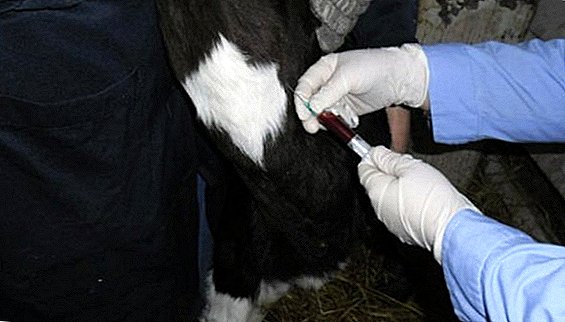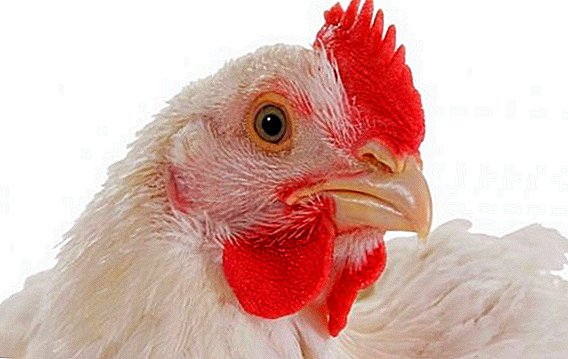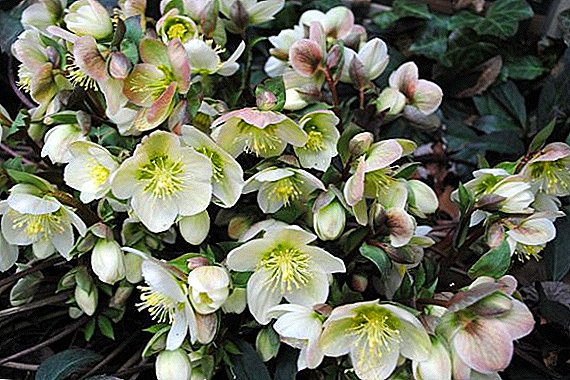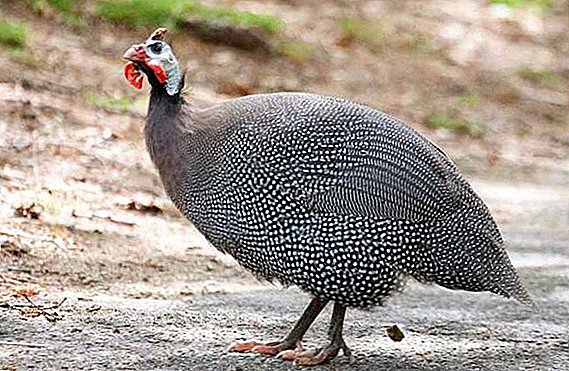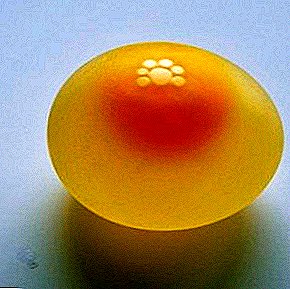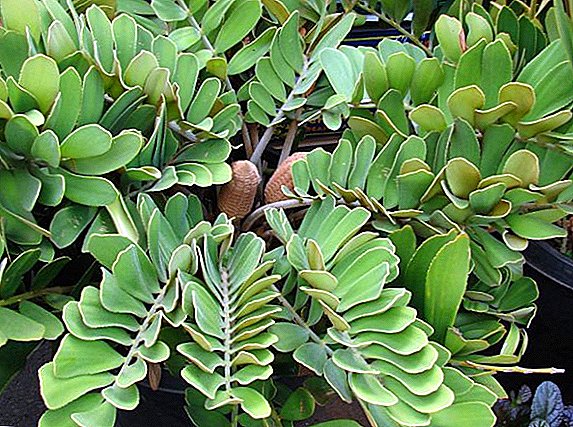 Today we will tell you the secrets of planting and growing a "dollar tree".
Today we will tell you the secrets of planting and growing a "dollar tree".
You will learn the basics of care and breeding, as well as a few interesting facts about the plant.
Did you know? In 1908, the director of the Berlin Botanical Garden, Adolph Engler, gave the modern name to a plant that received it due to the similarity of leaves with frost leaves.
Recommendations for the care of a dollar tree
 To get started, learn the general information about the dollar tree.
To get started, learn the general information about the dollar tree.
Zamioculcas - a plant that belongs to the family of Aroids and originates in tropical Africa.
A dollar tree has a thick tuber-like rhizome and glossy leaves.
Now that we have learned a little about Zamiokulkas, we can proceed to the recommendations for the care of the plant.
Soil composition requirements
To find out what kind of soil is needed for zamiokulkas, you need to remember which soils prevail in his homeland, in tropical Africa.
The flower requires loose soil, which will "breathe" well and pass moisture. You can buy soil in a flower shop and add some river sand. Or else to make the substrate for zamiokulkas by mixing in equal quantities turf soil, leaf soil (obtained as a result of rotting of fallen leaves), peat and river sand.
You can make an alternative "mix" of chernozem, peat and sand in equal proportions. When mixing the soil you need to add to it finely chopped sphagnum, which loosens the soil.
Important! A dollar tree prefers a soil with neutral acidity (pH at 6).
Content temperature and lighting
Zamioculkas unpretentious to the conditions of detention. It can be put both on the south and on the north window. A dollar tree is not afraid of drafts, in the warm season it feels great on the open balcony or in the garden.
 However, when choosing a place for the flower, take care of the lighting. The lack of light affects the color saturation of the leaves, in addition, new leaves grow weak and unsuitable for reproduction.
However, when choosing a place for the flower, take care of the lighting. The lack of light affects the color saturation of the leaves, in addition, new leaves grow weak and unsuitable for reproduction.
A dollar tree quietly tolerates both low and very high temperatures. The optimum temperature is 18-20˚С. In winter, he feels well at a temperature of + 16-18˚С.
Thus, an African plant can be kept in an apartment without creating a tropical hot climate. The plant does not need to extend the sunny day by installing an additional lamp.
Regular irrigation and humidity
Watering zamiokulkas need not too often. The soil should not be constantly wet, and even more so in winter. Add water to the pot when the soil on the surface becomes dry. In winter, watering is done when the substrate in the pot resembles a clod of dry earth.
We turn to humidify the air. A dollar tree feels great with minimal air humidity. However, do not forget to wipe the leaves of the plant at least once a month with a damp cloth so that dust and dirt will not accumulate on them.
Important! Excess moisture in the flowerpot leads to the fact that zamiokulkas yellow. Therefore, do not produce excessive watering, otherwise the plant will begin to ache and wither!
Fertilizer and top dressing
 If the plant inhibits growth and development, then you need to think about how you can feed a dollar tree.
If the plant inhibits growth and development, then you need to think about how you can feed a dollar tree.
Fertilizing a plant during the growing season should be once a week, alternating organic fertilizer with mineral fertilizer. The concentration of fertilizers should be 2 times less, so the finished dressing is diluted with water 1: 1.
Once a month, the dollar tree should be sprayed with urea or complex fertilizers. In this case, spray the body of the plant, and not the top layer of soil. Feeding up the plant according to the instructions, you save the color of the leaves, prevent disease and accelerate the growth of Zamiokulkas.
Features transplantation of zamiokulkas
In addition to fertilizing and watering, Zamiokulkas should be regularly transplanted into a new pot so that the plant is disease resistant and has a healthy appearance. When do you need to transplant a dollar tree in order not to injure the plant?
Zamiokulkasa transplantation is carried out in April or May. At the same time, it is important to transplant the plant along with the soil from the old pot. Thus, you need to immediately abandon pots that are smaller than the old "house" or identical in size with it.
Important! At home, transplanting a young dollar tree is carried out 1 time per year.

The plant is transplanted into a larger pot (3-4 cm larger than the old one in diameter), while the tops of the tubers of the roots do not cover the ground so that the root system does not become too wet. 2 days after transplantation, the plant should be watered abundantly.
It is best to replant the plant in a plastic pot with a narrowed bottom. However, it should not be very high, so that during the next transplant you would not have to split it.
Important! The deformation of the plastic pot indicates that the plant urgently requires a transplant.
As you can see, it is quite simple to transplant zamiokulkas at home.
Home reproduction
Many thought about how to multiply Zamiokulkas at home. In this section, we will answer this question and detail in detail the procedure for breeding a dollar tree.
Division of tubers
It is easy to propagate Zamiokulkas with tubers, as the tuber itself divides during growth. You just have to separate part of the tuber during a planned transplant of a plant.
Important! It is possible to divide tubers only when there is at least one growth point on the part to be separated. Otherwise, you simply damage the root system of the plant.
 Place the separation should be sprinkled with activated carbon crumbs and leave to dry. After that, plant the plant in a pot with a nutritious primer, pre-covering the bottom of the pot with drainage.
Place the separation should be sprinkled with activated carbon crumbs and leave to dry. After that, plant the plant in a pot with a nutritious primer, pre-covering the bottom of the pot with drainage.
This method of division is not the best, since there is a risk of the death of the mother plant. In addition, a separated tuber may not settle down. It is worth remembering that young plants are not transplanted in this way due to the lack of a sufficient number of tubers.
As you can see, it is very simple to root a dollar tree with tubers; this type of breeding is available even to inexperienced florists.
Cuttings
Propagation by cuttings has its advantages, because, firstly, the cutting contains more nutrients that facilitate rooting of the new plant, and secondly, cuttings can be propagated even when the plant has only 2-3 branches, which can be used as cuttings.
As a rule, take a shoot from a dollar tree is easy. To do this, do not need special tools, it is important only to follow the instructions.
 For breeding, choose a strong stalk of the optimal size (if you choose too small, then it will take longer to root). The selected process is separated with a knife from the mother plant and placed in water (we also add activated charcoal for disinfection).
For breeding, choose a strong stalk of the optimal size (if you choose too small, then it will take longer to root). The selected process is separated with a knife from the mother plant and placed in water (we also add activated charcoal for disinfection).
Important! For grafting choose part of the stem, on which there is at least 1 kidney.The water in the tank is periodically changed and monitored so that the cutting does not rot. As soon as the roots appear - the young plant is transplanted into the soil.
There is another variant of grafting, in which the plant is placed in the ground. After cutting the shoot, the place of separation is treated with crushed coal and left for a day without being placed in water or substrate. This is done so that the cutting closes the juice-conducting channels on the cut and forms a cork layer.
After a day, the stalk is placed in a moist, light, nutritious soil with the addition of peat and trace elements. To make it easier for the graft to settle down, you can install a greenhouse-cap above it (for this you can take an ordinary glass jar), which you sometimes need to remove for airing.
As soon as the first leaf with a reddish film appears on the plant, a cutting is taken. Watering a young plant is necessary so that water does not fall on the kidney (it is better to pour water around the perimeter of the pot).
Did you know? In addition to spathiphyllum, zamiokulkas are also called "female happiness". Many say that a flowering plant works wonders and makes its owner happy in love.
Leaf reproduction
 The easiest type of breeding, which does not require much time and other resources. During leaf reproduction, it is important to understand that the leaf is the entire branch that grows from the ground. The trunk of the zamiokulkas is in the ground and is a tuber with roots. So, for reproduction using small leaves, which are part of a large leaf.
The easiest type of breeding, which does not require much time and other resources. During leaf reproduction, it is important to understand that the leaf is the entire branch that grows from the ground. The trunk of the zamiokulkas is in the ground and is a tuber with roots. So, for reproduction using small leaves, which are part of a large leaf.
Before you multiply your plant, prepare a sharp knife and a container of water. Carefully cut the leaf off the dollar tree and lower it into the water so that 2/3 of the leaf is submerged in water. When cutting the leaflet you need to grab a small part of the stem.
From the moment you put the leaf in the water, and until the roots appear, it can take about 3-6 months, so do not sin on a bad leaf or the wrong instruction.
Important! For disinfection 1-2 tablets of activated carbon are placed in the water.
 Also cut sheet can be planted in peat. In this case, after cutting the sheet, it must be left to dry for one day, and only then “stick” into the peat. The leaf sets to 1/3 of the length and water with sufficient amount of water (do not over-wet the substrate, otherwise the leaf will simply rot).
Also cut sheet can be planted in peat. In this case, after cutting the sheet, it must be left to dry for one day, and only then “stick” into the peat. The leaf sets to 1/3 of the length and water with sufficient amount of water (do not over-wet the substrate, otherwise the leaf will simply rot).Next, the dishes with a sheet to cover with glass / can / polyethylene. Sheet from time to time need to be watered and aired. The time of germination of roots is the same as when immersed in a sheet of water.
Important! When planting a leaf in the substrate, you will not be able to see leaf rot, therefore we advise you to use water to control the germination process.
Possible problems in cultivation, diseases and pests of zamiokulkas
Money tree is affected by pests most often due to improper care. The most frequent "visitors" of the plant are the spider mite and the scythe.
Let's start with spider mitewhich is parasitic on the plant.

A small arachnid animal that feeds on plant sap. The tick is very small and difficult to see. The parasite inflicts severe damage to the plant, so you need to fight it urgently.
To destroy the pest, you can either soap solution (which need to wipe the entire body of the plant), or use specialized tools to combat the parasite - acaricides. Also spider mite is afraid of alcohol. Moisten a cotton swab with a 96% solution and wipe the entire plant.
Important! Only adults are afraid of alcohol, tick eggs will remain alive.
The second pest of a dollar tree - shield.
 Shchitovka belongs to the family of hemiptera insects. It parasitizes many plants, so Zamiokulkas is no exception. For the fight, you can use all the same soap solution from laundry soap, which is applied to the entire body of the plant.
Shchitovka belongs to the family of hemiptera insects. It parasitizes many plants, so Zamiokulkas is no exception. For the fight, you can use all the same soap solution from laundry soap, which is applied to the entire body of the plant.
After processing with soap, cover with plastic bag. The treatment is carried out several times until the parasite leaves the plant. We do not recommend the use of chemicals to combat the shield, as they are quite toxic, and spray them in a residential area is prohibited.
Important! Increased humidity is the first cause of the parasite on zamiokulkas.
In addition to parasites, zamiokulkas can suffer from diseases. Therefore, we will tell you how to identify the "sore" and cure it.
1. Dark spots on the leaves. There are several reasons: excessive moisture, draft or too low temperature. Reduce the amount of watering and move the flower pot to another location. After a while, the zamiokulkas will return to normal.
2. Rotting stalk. The plant begins to rot if it is watered excessively at low temperature. At the same time there is a characteristic putrid odor. In addition to the stem, the roots also begin to rot, so the situation must be rectified promptly so that the plant does not die.
To save a dollar tree, it is dug up and cut off the rotten parts. Slices are treated with activated carbon chips. After "resuscitation", the body of the plant must be treated with a fungicide and transplanted into another pot with new soil.
Important! If the process is irreversible, the tuber is discarded, leaving all healthy leaves for reproduction. Thus, you can restore the plant.3. The plant began to dry. Zamioculcas dries and sheds leaves for two reasons: aging or mechanical damage. So do not worry, just carefully clean the leaves and the stem, so that the plant is not injured.
 4. Yellowing of the leaves. We recalled this problem above, when we discussed the irrigation regime. Yellow leaves appear on the plant when there is a surplus of moisture. Also, if rot appears on the roots, the leaves will begin to turn yellow. To cure a plant, you just need to dry the soil or, if it is in a neglected state, transplant it into a new dry substrate.
4. Yellowing of the leaves. We recalled this problem above, when we discussed the irrigation regime. Yellow leaves appear on the plant when there is a surplus of moisture. Also, if rot appears on the roots, the leaves will begin to turn yellow. To cure a plant, you just need to dry the soil or, if it is in a neglected state, transplant it into a new dry substrate.
5. Stains on the stem. If the spots are not wet / soft to the touch, then this is just a feature of the plant. Also dark spots left behind scutes. Yellow dry spots on the leaves appear after sunburn. In this case, just change the place, and the plant itself will be restored.
Pruning Zamiokulkas
With the main pests and diseases of the dollar tree, we figured out, now we begin pruning zamiokulkasa.
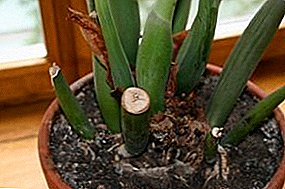 Pruning plants spend in the spring. During rapid growth, the upper kidney, which receives the most nutrients, is gently removed. Shoots pruned so that in the end the crown resembled the shape of a ball. After pruning, the dollar tree immediately forms the lower buds, which then turn into young shoots.
Pruning plants spend in the spring. During rapid growth, the upper kidney, which receives the most nutrients, is gently removed. Shoots pruned so that in the end the crown resembled the shape of a ball. After pruning, the dollar tree immediately forms the lower buds, which then turn into young shoots.
Important! You can not pruning in the winter, as the plant for this period goes into hibernation and ceases to grow.Now you know that keeping a dollar tree at home is not as difficult as it may seem. Do not forget about the care of the plant, and it will always please you.


